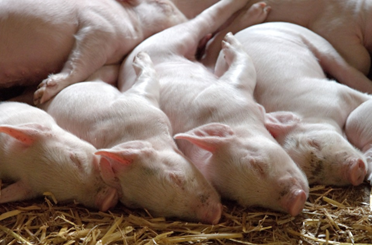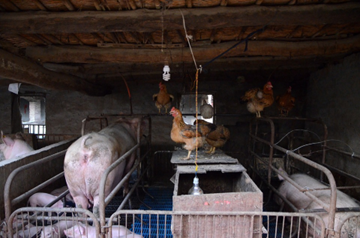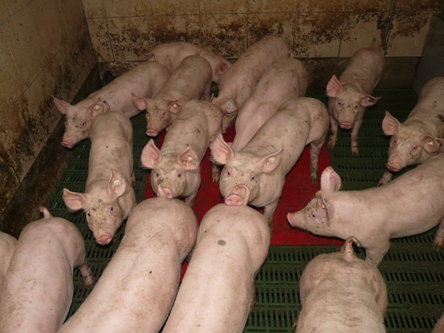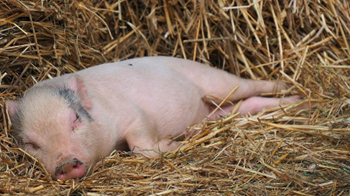9 September 2022
Symptoms of piglet stress
Stress is difficult to pinpoint because it constitutes a normal physiological process. When any organism is challenged by less-than-ideal conditions, it has to adapt in order to survive. For example, if the weather gets nippy, pigs produce more heat to stay warm and modify their behaviour, cuddling together or seeking shelter. The goal is to maintain homeostasis: the inner equilibrium of all living organisms.
In normal conditions, healthy pigs can adapt to challenges in their environment. However, the balance can be lost as the result of intrinsic factors (low weight, low viability) or extrinsic (peer competition, unfavourable environment, pathogens). Stressors are events that push the pig out of homeostasis and elicit an adaptive response. If the response is insufficient (or the stressor too intense or prolonged) then we see piglet stress symptoms:
- Ill-thrift
- Low activity level
- Separation from the litter
- Poor growth
- Aberrant behaviours (such as tail biting)
- Increased fighting among littermates
- Scours and other diseases
- Increased mortality
Stressors act together and compound, which is why you see a snowball effect. A typical example is how hypoxia (low oxygen levels) due to dystocia leads to decreased colostrum intake, which leads to chilling, which leads to slower movement, which leads to crushing.
When you see a problem, such as scour, it is easy to take action. The problem with stress is that it usually takes piglets to the edge where they can adapt without showing any signs, but just barely. In this case, you won’t see the consequences of stress, except on your balance sheet.
The best strategy to manage stress in pre-weaning and weaning piglets is to understand its causes, rather than go looking for its signs.
Causes of piglet stress in the farrowing unit
In industrial pig farming, pigs are taken to the limit of their physiological capabilities to maximise output. This means that pigs in modern farms are already under a lot of stress. For this reason, when anything goes wrong in a technified modern type of the farm, it has a greater impact than when it happens in more traditional systems.
In short, a host of factors can become stressors in the farrowing unit, ranging from temperature to overcrowding, and from pathogens to over-handling. Therefore, farrowing unit management is the best strategy to manage stress and its effects. Let’s take a look at the most important causes of piglet stress in the farrowing area:
Temperature
Piglets have a high weight to surface ratio, which means they lose heat at a faster rate than adults. Furthermore, piglets do not have the ‘brown fat’ that other species’ offspring do. This means that piglets face an increased risk of chilling. This is why drying and rubbing are such important parts of farrowing assistance.
Providing external heat sources is a common strategy to avoid chilling. However, not all piglets take well to the creep area and creep training may be necessary. Controlling the temperature in the farrowing area is also a good idea. 22 °C is an appropriate compromise between the most suitable temperature for the piglets and for the sows. Newborn piglets are most comfortable at around 30-35 °C, whereas sows enjoy a much cooler 15-20 °C. The added complexity arises from the fact that higher temperatures can cause anorexia in sows and therefore decrease colostrum/milk production, which has dire consequences for piglets.
Heat can also act as a stressor. In fact, Johnson et al. (2018) proved that heat stress in early life (pre-weaning) predisposes piglets to greater stress effects later in life, especially during weaning.
Peer competition
One of the breeding goals in the last decades has been prolificacy (the number of piglets per litter). Unfortunately, this production benchmark has had negative consequences. Large litters increase competition among littermates and, in part because of prolificacy, piglet mortality has blighted the industry.
Peer competition becomes an obvious stressor when there are not enough teats available for all the piglets. Underweight or less-viable piglets will have to waste precious resources to fight for their spot at the udder.
If the situation is further complicated by poor environmental conditions, smaller piglets simply don’t stand a chance. But even if they don’t die, their performance (best measured at weaning weight) will be lacklustre. Peer competition begins in utero, because there is less space in the womb for development (small piglets become even smaller) and there is a higher risk of hypoxia and even iron deficiency.

Piglets naturally seek their peers for warmth and protection.
Under stress conditions, their allies can become their fiercest competitors
A further complicating factor is litter heterogeneity. Heavy piglets thrive in heterogeneous litters whereas smaller ones fall victim to stress. For this reason, litter equalisation through cross-fostering techniques is crucial to reducing piglet mortality. Nevertheless, caution should be exercised because, as Calderón Díaz et al. (2018) and Huting et al. (2017) discuss, cross-fostering can be detrimental to heavy piglets when they are placed alongside similar-sized piglets.
Cross-fostering can cause a lot of stress to piglets! Therefore, the farrowing unit should have a clear policy and personnel should be trained in these techniques. As a general rule, try to cross-foster piglets within the first 48 hours (not before 12-24h after birth) and try to ensure they have had their biological dam’s colostrum. The biggest pitfalls of cross-fostering are doing it all throughout the first week of life (which causes a lot of stress) and mixing groups, which dramatically increases the risk of diseases spreading and segues into our next topic…
Pathogens
Infectious diseases are an important cause of mortality in the farrowing unit. However, they can also cause stress. Viruses, bacteria, and parasites attack the newborn piglet which tries to fend off these aggressors with its innate immunity and the life-saving antibodies it has inherited from its dam through colostrum.
However, if the pathogens are too many, defences eventually run out. Furthermore, one of the physiological consequences of stress is that resources are redirected towards maintaining basic life functions; in other words, when a piglet is struggling just to stay warm, its body won’t invest in its immune system.
The ‘pathogen burden’ in the farrowing area is the concept to keep in mind. Dirty pens, overflowing slurries, vermin, and lack of disinfection often mean that there is a multitude of pathogens circulating in the environment; so many in fact that can overcome even healthy piglets’ defences.
Take Coccidia as an example. These fastidious parasites colonise the gut lining of piglets and reproduce to shed thousands of egg-like structures called ‘oocysts’. Oocysts are very resistant to environmental conditions. Coccidia often overwhelm healthy litters, producing a watery-to-pasty scour that translates as significant losses to the farmer. Therefore, biosecurity, cleaning and disinfection are paramount in reducing the pathogen burden.
Another strategy that should be used to reduce the impact of pathogens in the pre-weaning period is vaccinating the sows pre-farrowing. This produces disease-specific antibodies that are then passed on to the piglets via colostrum. Especially important is vaccination agains Neonatal Diarrhoea (ND) which is caused by several pathogens like C. perfringens type A. For Coccidia, piglets should receive coccidiostats as metaphylaxis.

Unsanitary conditions increase the pathogen burden.
However, stress is the determinant factor that pushes piglets ‘off the edge.’
Overcrowding and poor farrowing pen design
Farms face a predicament. Overcrowding is a major cause of stress in piglets, but maximising space and labour makes sense financially.
In the first days of life, piglets don’t need a lot of space. However, because of their fast growth rate, this changes quickly. If piglets need to fight for access to resources, aggression and competition can become a problem, leading to stress in the weaker littermates. This is usually only a problem for larger litters.
Slated floors also increase the need for external heat sources and can increase unwanted behaviours. From an animal welfare standpoint, the most pressing concern in the industry is sow restriction to reduce crushing.
Overcrowding is not a big issue in the farrowing area, but it certainly is a principal stressor in the grower and finisher areas. So, what does this have to do with the farrowing unit? Well, since batch farrowing has gained momentum —and it certainly has many advantages— farmers would do well to avoid its major pitfall: overfarrowing. If batch farrowing is not calculated correctly, grower and finisher areas will face a serious overcrowding problem. For optimal follow and capacity in farrowing house, synchronisation of gilts with altrenogest is proven effective tool.

Overcrowding leads to stress and increases unwanted behaviours such as tail biting.
Aggression, aberrant behaviours, and impoverished environments
Aggression and abnormal behaviours are both the cause and the result of stress in piglets. Let’s unpack this statement.
A certain degree of aggressive behaviour is normal in piglets; in fact, some of it is manifested as play. Aggression is regulated within the litter by two factors: pushback and the possibility of redirection. When piglets defend themselves, aggression becomes somewhat ritualistic and serves to establish a hierarchy. However, when a littermate is defenceless, the burden of aggression is greater and stress ensues, leaving that piglet at a higher risk of becoming the victim of aggression. This is why smaller piglets in heterogeneous litters suffer more aggression.
Most aggressive behaviours aim at establishing a hierarchy, not at hurting others. Usually, the defeated piglet has to signal that it concedes access to resources by moving away. When piglets don’t have the space to move or conceding would mean death, they have to stand their ground and aggression escalates, leading to overall stress and more aggression. For example, if there are not enough teats, aggression frequency and intensity increase.
Aberrant behaviours such as tail biting are usually ‘redirected’ behaviours. All animals have certain behaviours they are programmed to execute. When they can’t express these behaviours because of an impoverished environment, they redirect their impulses towards an abnormal object.
For example, one could argue that tail biting is a redirected behaviour of furrowing. Providing furrowing materials reduces tail biting significantly. In fact, providing straw can reduce tail biting by 50% (Sutherland & Tucker, 2011).

Straw and other furrowing materials allow piglets to express their natural behaviours.
Nevertheless, these substrates create biosecurity problems of their own.
Impact of humans on pig behaviour
Human-pig interaction is one of those rare areas where less is more.
In the farrowing area, good stockmanship begins with the handling of the sows, which are large and dangerous animals. Moving sows to the farrowing pens is a task that should be left for those with experience and tact. Good workers usually maintain a calm demeanour, are patient, and never resort to shouting or hitting. This calmness has a surprising effect on sows, which seem to obey of their own volition. Compare this with inexperienced workers, who frequently run into trouble.
When performing tasks such as cleaning, checking feeding trays, and handling piglets, it is important to work efficiently but calmly. Prepare everything you will need beforehand to avoid having to handle piglets twice.
As you move through the farrowing area, do so confidently, quietly, and without brusque movements. Shouting should not be allowed. Pigs are very sensitive animals, so if something is annoying to you, it is likely it is also annoying to the piglets and could cause stress. Loitering is not only a biosecurity concern but can also lead to stress; if there is no reason for someone to be in the farrowing area… they shouldn’t be in the farrowing area!
This doesn’t mean that the farrowing area should be left unattended. On the contrary, piglets and sows should be accustomed to seeing people, and it is important for workers to keep an eye open for diseases and other problems.
How piglet management impacts stress
During the pre-weaning period, there are some important piglet care and management tasks that have to be accomplished. Some of the most important are:
- Castration
- Tail docking
- Teeth clipping
- Ear tagging
- Weighing
- Coccidiosis prophylaxis
- Iron supplementation
Each of these tasks is a stressor in its own right. It is well known that castration leads to a transitory decrease in milk intake and other symptoms of stress. The same can be said of tail docking and teeth clipping. Even if these management tasks are performed expertly, piglets also experience stress.
There are also animal welfare concerns with practices such as castration and tail docking. In Europe, there has been a push in recent years to rid the industry of these. The results are somewhat mixed. For example, most pigs in northern European countries are still castrated; however, Spain, Ireland, and the UK have a long tradition of turning out entire males.
It is likely that, in the future, the industry will veer towards a hands-off approach. This makes sense from a stress perspective and it is what we should aim for in our farms. Management should be kept to a minimum and it should be done with the least amount of handling.
Injections are a good example of this minimalist approach. While in the past coccidiostats and iron would be injected separately, some products allow farmers to cut the injections by half, which reduces handling and, ultimately, stress.
References
Alarcón, L. V., Allepuz, A., & Mateu, E. (2021). Biosecurity in pig farms: a review. Porcine Health Management, 7(1), 1-15. https://doi.org/10.1186/s40813-020-00181-z
Calderón Díaz, J. A., García Manzanilla, E., Diana, A., & Boyle, L. A. (2018). Cross-fostering implications for pig mortality, welfare and performance. Frontiers in Veterinary Science, 5, 123. https://www.frontiersin.org/articles/10.3389/fvets.2018.00123/full
Declerck, I., Sarrazin, S., Dewulf, J., & Maes, D. (2017). Sow and piglet factors determining variation of colostrum intake between and within litters. Animal, 11(8), 1336-1343. https://doi.org/10.1017/S1751731117000131
Faccin, J. E., Laskoski, F., Cemin, H. S., Mellagi, A. P., Bernardi, M. L., Ulguim, R. R., Bortolozzo, F. P., & Tokach, M. D. (2020). Evaluating the impact of weaning weight and growth rate during the first week post weaning on overall nursery performance. Journal of Swine Health and Production, 28(2), 70-78. https://www.aasv.org/shap/issues/v28n2/v28n2p70.html
Gallois, M., Le Cozler, Y., & Prunier, A. (2005). Influence of tooth resection in piglets on welfare and performance. Preventive Veterinary Medicine, 69(1-2), 13-23. https://doi.org/10.1016/j.prevetmed.2004.12.008
Hales, J., Moustsen, V. A., Nielsen, M. B., & Hansen, C. F. (2014). Higher preweaning mortality in free farrowing pens compared with farrowing crates in three commercial pig farms. Animal, 8(1), 113-120. https://doi.org/10.1017/S1751731113001869
Holyoake, P. K., Broek, D. J., & Callinan, A. P. L. (2004). The effects of reducing the length of canine teeth in sucking pigs by clipping or grinding. Australian Veterinary Journal, 82(9), 574-576. https://doi.org/10.1111/j.1751-0813.2004.tb11207.x
Huting, A. M. S., Almond, K., Wellock, I., & Kyriazakis, I. (2017). What is good for small piglets might not be good for big piglets: the consequences of cross-fostering and creep feed provision on performance to slaughter. Journal of Animal Science, 95(11), 4926-4944. https://doi.org/10.2527/jas2017.1889
Jarvis, S., D'Eath, R. B., & Fujita, K. (2005). Consistency of piglet crushing by sows. Animal welfare, 14(1), 43-51. https://www.ingentaconnect.com/content/ufaw/aw/2005/00000014/00000001/art00006
Johnson, J. S., Aardsma, M. A., Duttlinger, A. W., & Kpodo, K. R. (2018). Early life thermal stress: Impact on future thermotolerance, stress response, behavior, and intestinal morphology in piglets exposed to a heat stress challenge during simulated transport. Journal of Animal Science, 96(5), 1640-1653. https://doi.org/10.1093/jas/sky107
Kemper, N. (2020). Update on postpartum dysgalactia syndrome in sows. Journal of animal science, 98(Supplement_1), S117-S125. https://doi.org/10.1093/jas/skaa135
Maskal, J. M., Duttlinger, A. W., Kpodo, K. R., McConn, B. R., Byrd, C. J., Richert, B. T., Marchant-Forde, J. N., Lay, D. C., Perry, S. D., Lucy, M. C., Safranski, T. J., Johnson, J. S., & Johnson, J. S. (2020). Evaluation and mitigation of the effects of in utero heat stress on piglet growth performance, postabsorptive metabolism, and stress response following weaning and transport. Journal of animal science, 98(9), skaa265. https://doi.org/10.1093/jas/skaa265
Muns, R., Nuntapaitoon, M., & Tummaruk, P. (2016). Non-infectious causes of pre-weaning mortality in piglets. Livestock Science, 184, 46-57. https://doi.org/10.1016/j.livsci.2015.11.025
Nicolaisen, T., Lühken, E., Volkmann, N., Rohn, K., Kemper, N., & Fels, M. (2019). The effect of sows’ and piglets’ behaviour on piglet crushing patterns in two different farrowing pen systems. Animals, 9(8), 538. https://doi.org/10.3390/ani9080538
Ocepek, M., & Andersen, I. L. (2017). What makes a good mother? Maternal behavioural traits important for piglet survival. Applied animal behaviour science, 193, 29-36.
Ozsvary, L. (2018) Production Impact of Parasitisms and Coccidiosis in Swine. Journal of Dairy, Veterinary & Animal Research, 7(5), 217-222. http://dx.doi.org/10.15406/jdvar.2018.07.00214
Pajžlar, L., & Skok, J. (2019). Cross-fostering into smaller or older litter makes piglets integration difficult: Suckling stability-based rationale. Applied Animal Behaviour Science, 220, 104856. http://dx.doi.org/10.15406/jdvar.2018.07.00214
Sutherland, M. A., & Tucker, C. B. (2011). The long and short of it: A review of tail docking in farm animals. Applied Animal Behaviour Science, 135(3), 179-191. https://doi.org/10.1016/j.applanim.2011.10.015
Tucker, B. S., Craig, J. R., Morrison, R. S., Smits, R. J., & Kirkwood, R. N. (2021). Piglet Viability: A Review of Identification and Pre-Weaning Management Strategies. Animals, 11(10), 2902. https://doi.org/10.3390/ani11102902
Vaillancourt, J. P., Stein, T. E., Marsh, W. E., Leman, A. D., & Dial, G. D. (1990). Validation of producer-recorded causes of preweaning mortality in swine. Preventive Veterinary Medicine, 10(1-2), 119-130. https://doi.org/10.1016/S0749-0720(15)30711-8
Valros, A., & Heinonen, M. (2015). Save the pig tail. Porcine Health Management, 1(1), 1-7. https://doi.org/10.1186/2055-5660-1-2
Vande Pol, K. D., Bautista, R. O., Harper, H., Shull, C. M., Brown, C. B., & Ellis, M. (2021). Effect of rearing cross-fostered piglets in litters of either uniform or mixed birth weights on preweaning growth and mortality. Translational Animal Science, 5(1), txab030. https://doi.org/10.1093%2Ftas%2Ftxab030
Vande Pol, K. D., Tolosa, A. F., Shull, C. M., Brown, C. B., Alencar, S. A., Lents, C. A., & Ellis, M. (2021). Effect of drying and/or warming piglets at birth under warm farrowing room temperatures on piglet rectal temperature over the first 24 h after birth. Translational Animal Science, 5(3), txab060. https://doi.org/10.1093/tas/txab060
Vidal, A., Martín-Valls, G. E., Tello, M., Mateu, E., Martín, M., & Darwich, L. (2019). Prevalence of enteric pathogens in diarrheic and non-diarrheic samples from pig farms with neonatal diarrhea in the North East of Spain. Veterinary Microbiology, 237, 108419. https://doi.org/10.1016/j.vetmic.2019.108419
